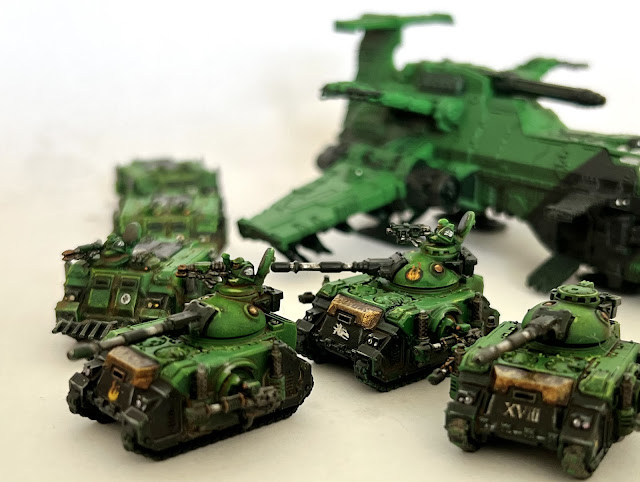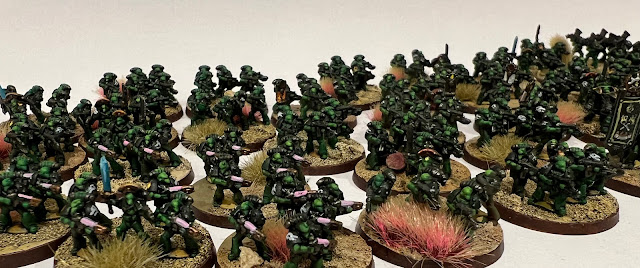+ Lesson from painting Epic models +
+ I thought I'd scribble down some notes on painting Epic models; perhaps they'll be helpful to you – or at least let you avoid my mistakes! +
+++
+ Detailing Epic models +
+ Theoretical +
+ Epic-scale models present different challenges to larger scales, and offer a good lesson in simplification. The new Epic Legions Imperialis models are quarter of the size of their 40k counterparts, and unlike older Epic models, are minimally adapted to the new scale, without the exaggeration of the Epic 40,000-era amodels, such as the Dreadnoughts here [+noosphericinloadlink embedded+]: +
 |
| Even in death I still serve (as an example of stylistic changes in sculpting). |
+ Techniques and approaches that work at 40k don't necessarily translate well. Subtle highlights and shading get lost or look muddy, and if you try to replicate what you did for your larger models, you're effectively painting with a brush four times the size you'd use for their larger counterparts. +
+ I've found it better to take a step back and re-assess. Depending on the effect you want, of course, the key points I'd flag when swapping to Epic scale are:
- Lost light Small models reflect less light – so need to be treated differently.
- The crowd effect As a mass, Epic models show less individuality than their 40k equivalents. Differences clear at 40k scale might be lost entirely for Epic models at table distance.
- Space for variation Mass models are more visually coherent, so variations in painting and finishing offer opportunities for personalisation that won't 'read' at typical distances.
+ Practical +
+ Lost light +
+ Highlighting on models is intended to simulate the amount of light reflected from the full-scale object – that's what makes a model look like something big at a distance, rather than small and close up. +
 |
| Highlighting and shading on the Rhino add visual texture and detail that make the surfaces look more distant than the flatter planes of the base-coated Thunderhawk. |
+ In other words, a full sized Space Marine would need no highlighting, because the surfaces would naturally reflect the right amount of light. A 40k-scale model requires you to artificially exaggerate the highlighting and shading through use of paint. +
+ At quarter of the size of the 40k Space Marine, the contrast between light and dark areas of an Epic model needs to be pushed that much more to get a similar visual impact. +
Of note is that this might not be the style you want – loss of detail and reduction in saturation and contrast are real world signifier of distance, thanks to aerial perspective. As a result, you might want to simulate this for a particular effect – in which case you need to steer clear of edge highlighting and surface modelling.
+++
+ This is where techniques suitable for 40k don't necessarily translate. The reasons for this vary by technique. To take layering as an example, each layer of paint you add is proportionally four times thicker; the brushstrokes four times more obvious. This means you should be careful with the number of layers – you might not notice it on a 40k scale tank, but an Epic one will start to pick up texture four times faster. +
+ The answer to this? At its most simple, use a light touch. The good news is that because the areas you are covering are smaller, it's easier to get good coverage with fewer layers. Be sparing, and avoid overworking things. +
+++
+ Surface tension is another consideration. Whatever the size you're working, the surface tension of water is going to be consistent. When using thinned paints, you'll need to adapt to working in small areas. At Epic scale, there are fewer large, smooth areas, and relatively more greebling that means fluid paints won't necessarily behave in quite the way you're expecting. +
+ You can use flow improver medium to help adapt to this (I recommend this anyway), but it's also important not to treat this change as inherently problematic. It's as much an advantage as anything, as the smaller surfaces mean less puddling and pooling. +
+ Contrast paints really come into their own here, and while I've only used Black Templar for these models, I thoroughly recommend their use for Epic in general – they're ideal for turning all the points above into advantages, naturally giving richer, more saturated and cleaner results than on 40k models. +
+++
+ The crowd effect +
+ What do I mean that Epic-scale models show less individuality than 40k-scale models? Simply that at typical working distances, Epic-scale models are far less visually distinct from one another, which you should be aware of. The combination of there being more of them, and each individual figure or tank being smaller (and thus giving less space for conversion work than their 40k equivalents) means that they'll tend to blend into one another more. ++ Uniformity isn't necessarily a bad thing – indeed, massed ranks of similar models is a key part of the appeal of Epic scale gaming. Nevertheless, it's worth being aware of it both for display and for gaming reasons. +
+ The image below shows my Salamanders infantry. See how quick you are to identify the various different types in relative close-up:
 | |
|
+ ... and again, at roughly half the size; something closer to tabletop distance. +
 |
| + Included here are Tactical stands, Plasma support stands, Missile Launcher Devastators, Terminators and Command stands. + |
+ As I hope this demonstrates, at table distance all these different types tend to blend into one another. You might, of course, rather like this – the sea of infantry is definitely a look I favour – but if you want immediate identification, consider exaggerating the differences. You might paint plasma weaponry in a more strongly-contrasting accent than at 40k scale, for example. +
+ Gun casings are a good place to add an eye-catching marking, or even paint different types of weapon with different colours. This would probably look a bit too obvious at 40k scale, but Epic-scale can stand a little less consistency in such details, in favour of being easier to 'read'. +
+++
+ Markings are also worth thinking about. Space is at a premium, and since you have so many more models, identification becomes more important. The work-in-progress armour below shows models prior to the markings being added. +
+ They're perfectly servicable, and you could happily game with them at this stage, but markings will both add character and help draw the viewer's eye. This is beneficial whether you're intending them for display or gaming. For display, such details stop the eye drifting over the mass (the crowd effect) and serve as visual punctation. For gaming, markings will help you and the other players to identify particular detachments or formations – particularly useful to spot where one group starts and ends. +
+ As a nod to a 2nd edition Space Marine article and the artwork to The Battle for Armageddon boxed game, I'm intending to use the symbols from a deck of cards for my army. This will also be handy on the army list, as I can put the relevant symbol next to the infantry each group of Rhinos is carrying – little touches like this can help speed of comprehension and avoid misunderstandings. +
+ Make sure they're readable! This test model shows the importance of checking things and practice. Just about visible here are 'club' symbols. For a 40k-scale model, I think they'd work well, clear but not too over the top. For these Epic models at table distance, however, the markings are nothing more than blobs. For future models, I'll take up much of the top hatch with the appopriate symbol. +
+ When choosing symbols, I suggest that you keep things clear and simple. Numerals, letters, Codex markings... all will work well. +
+++
+ Space for variation and personalisation +
+ The flip side of things being lost at small scale is that you can have lots of fun with extra detailing, if you want! As there's less stuff at the right size, and a smaller range overall, there's less opportunity for easy kitbashing than at 40k scale. +
+ However, such details are almost certain to be lost – even to an interested observer – unless you point them out. Does this make them not worth doing? Of course not! Such customisation is fun – and that's really the key thing to take away from painting Epic models. They're quick, and fun, and surprisingly different from painting 40k-scale models. +
+ The scale does necessitate some compromises. The banner here, for example is a simplification of the 40k-era 2nd Company banner (as my army's themed around the Second War for Armageddon) – and while I've taken more time on this stand than the others (eye lenses on the models, for example), I've consciously avoided getting sucked down a rabbit hole of trying to superdetail such tiny figures. While it's possible, it's beyond my current skill level, and my priority is to get a gaming army together. +
+ This picture also shows another good example of simplification: the Salamanders' Chapter badge – visible on the Tactical stand on the right-hand side of the picture. At this scale, it's clear that it's a super-simplified version of the icon – but even this is unnecessary. +
+ Decide before you begin what you want to simplify; and whether you want to include such detail at all. There is no shame at all in a simple approach – as we've seen above, you can spend a great deal of effort in gilding the lily, and creating detail that will be seen only vanishingly rarely, even on the display shelf. +
+ In summary, my advice is to concentrate on that mass of figures – get the impact through simplicity and leaning into the inherent advantages that Epic scale gives you. +
+++
+ The Corsair Gambit +
+ Time is closing in for me to complete my Salamanders in time for this event, but painting is progressing. Above you can see the first three Predators of Destructor Squadron, which I polished off after getting a bit bored with batch painting the remaining tanks. +
+ The list from this inload [+noosphericinloadlink embedded+] details what needed to be done; so here's an update:
+ Completed since +
- One additional stand of Terminators
- Two stands of Assault Marines
- Support: Four Dreadnoughts
- Support: Four Dreadnoughts
- Battle Tank: Three Predators
- Transport: Eight Rhinos
+ Still to do +
- Air Support: Thunderhawk Gunship
- Bastion: Four Tarantulas
- Battle Tank: Six Predators
- Transport: Five Rhinos.
- Transport: Five Rhinos.
- Three objectives
+ Aside from the objectives, which are primed at best, the remainder has had the black and metalwork picked out, and is ready for washes, highlights and detailing. I'm hoping to have that all done after Wednesday night, giving me a day's grace in detailing. +








The Sallies look fantastic all together. Great job on a massive (tiny) scale!
ReplyDeleteI simply cannot state how much I love your work on this project. Amazing!
ReplyDelete